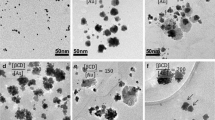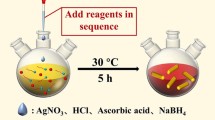Abstract
Acanthosphere-like gold microstructures (AGMs) were synthesized using a facile, two-step, seed-mediated method and butanediyl-1,4-bis(dimethylhexadecylammonium bromide) (16-4-16) as a structure-directing agent. The morphologies and sizes of the products were controlled during the synthesis process by adjusting the concentrations of 16-4-16, the AgNO3 feed, HAuCl4, ascorbic acid, the amount of Ag seeds and the types of gemini surfactants used through systematic inquiry; particle sizes ranging from 130 to 800 nm were well prepared. Correspondingly, the morphology of the products changed between regular and irregular AGMs, and the products presented a number of new morphologies, such as open-mouthed submicrostructures and ribbon nanowires. In particular, with the increase in the 16-4-16 concentration, the structural morphology of the thorns clearly changed from a tip to a lamellar structure. A UV-vis spectroscopic analysis indicated that the localized surface plasmon resonance (LSPR) peak of the AGMs could be adjusted by changing the above factors, which extended from 500 to 1350 nm in the near-infrared (NIR) region, enabling a tremendous potential for using the AGMs as platforms for various biomedical applications. Based on the intermediate products, we propose a two-stage growth mechanism for the AGMs in which their solid cores and tips are generated successively. Surface-enhanced Raman scattering (SERS) measurements indicate that the AGMs can serve as sensitive SERS substrates; a SERS detection limit of 5 × 10−7 M is presented for rhodamine B molecules.

Graphical abstract












Similar content being viewed by others
References
Alami E, Beinert G, Marie P, Zana R (1993) Alkanediyl-.alpha.,.omega.-bis(dimethylalkylammonium bromide) surfactants. 3. Behavior at the air-water interface. Langmuir 9:1465–1467
Bakr OM, Wunsch BH, Stellacci F (2006) High-yield synthesis of multi-branched urchin-like gold nanoparticles. Chem Mater 18:3297–3301
Bakshi MS (2016) How surfactants control crystal growth of nanomaterials. Cryst Growth Des 16:1104–1133
Bhattacharya S, Biswas J (2011) Role of spacer lengths of gemini surfactants in the synthesis of silver nanorods in micellar media. Nano 3:2924–2930
Chen L, Ji F, Xu Y, He L, Mi Y, Bao F, Sun B, Zhang X, Zhang Q (2014) High-yield seedless synthesis of triangular gold nanoplates through oxidative etching. Nano Lett 14:7201–7206
Chen Q, Jia Y, Xie S, Xie Z (2016) Well-faceted noble-metal nanocrystals with nonconvex polyhedral shapes. Chem Soc Rev 45:3207–3220
Chen SH (1986) Small angle neutron scattering studies of the structure and interaction in micellar and microemulsion systems. Annu Rev Phys Chem 37:351–399
Cheng L, Ma C, Yang G, You H, Fang J (2014) Hierarchical silver mesoparticles with tunable surface topographies for highly sensitive surface-enhanced Raman spectroscopy. J Mater Chem A 2:4534–4542
De S, Aswal VK, Goyal PS, Bhattacharya S (1996) Role of spacer chain length in dimeric micellar organization. Small angle neutron scattering and fluorescence studies. J Phys Chem C 100:11664–11671
Fang J, Du S, Lebedkin S, Li Z, Kruk R, Kappes M, Hahn H (2010) Gold mesostructures with tailored surface topography and their self-assembly arrays for surface-enhanced Raman spectroscopy. Nano Lett 10:5006–5013
Figueira-Gonzalez M, Francisco V, Garcia-Rio L, Marques EF, Parajo M, Rodríguez-Dafonte P (2013) Self-aggregation properties of ionic liquid 1,3-didecyl-2-methylimidazolium chloride in aqueous solution: from spheres to cylinders to bilayers. J Phys Chem B 117:2926–2937
Gilroy KD, Ruditskiy A, Peng H, Qin D, Xia Y (2016) Bimetallic nanocrystals: syntheses, properties, and applications. Chem Rev 116:10414–10472
Graciani MM, Rodriguez A, Martin VI (2010) Concentration and medium micellar kinetic effects caused by morphological transitions. Langmuir 26:18659–18668
Guerrero-Martinez A, Perez-Juste J, Carbo-Argibay E, Tardajos G, Liz-Marzan LM (2009) Gemini surfactant directed self-assembly of monodisperse gold nanorods into standing superlattices. Angew Chem Int Edit 48:9484–9488
Guo L, Xu Y, Ferhan AR, Chen G, Kim D (2013) Oriented gold nanoparticle aggregation for colorimetric sensors with surprisingly high analytical figures of merit. J Am Chem Soc 135:12338–12345
Hait S, Moulik SP (2002) Gemini surfactants: a distinct class of self-assembling molecules. Curr Sci India 82:1101–1111
Han J, Zhou Z, Yin Y, Luo X, Li J, Zhang H, Yang B (2012) One-pot, seedless synthesis of flowerlike au-Pd bimetallic nanoparticles with core-shell-like structure via sodium citrate coreduction of metal ions. CrystEngComm 14:7036–7042
Jain T, Tehrani-Bagha AR, Shekhar H, Crawford R, Johnson E, Nørgaard K, Holmberg K, Erhart P, Moth-Poulsen K (2014) Anisotropic growth of gold nanoparticles using cationic gemini surfactants: effects of structure variations in head and tail groups. J Mater Chem C 2:994–1003
Jiji SG, Gopchandran KG (2015) Synthesis of gold nanoflowers and their high SERS performance. Mater Today 2:928–933
Ke FS, Solomon B, Ding Y, Xu GL, Sun SG (2014) Enhanced electrocatalytic activity on gold nanocrystals enclosed by high-index facets for oxygen reduction. Nano Energy 7:179–189
Kelly KL, Coronado E, Zhao LL, Schatz GC (2003) The optical properties of metal nanoparticles: the influence of size, shape, and dielectric environment. J Phys Chem B 107:668–677
Khoury CG, Vo-Dinh T (2008) Gold nanostars for surface-enhanced Raman scattering: synthesis, characterization and optimization. J Phys Chem C 2008:18849–18859
Kneipp K, Kneipp H, Itzkan I, Dasari RR, Feld MS (1999) Ultrasensitive chemical analysis by Raman spectroscopy. Chem Rev 99:2957–2976
Kulak AN, Iddon P, Li Y, Armes SP, Colfen H, Paris O, Wilson RM, Meldrum FC (2007) Continuous structural evolution of calcium carbonate particles: a unifying model of copolymer-mediated crystallization. J Am Chem Soc 129:3729–3736
Li J, Wu J, Zhang X, Liu Y, Zhou D, Sun H, Zhang H, Yang B (2011) Controllable synthesis of stable urchin-like gold nanoparticles using hydroquinone to tune the reactivity of gold chloride. J Phys Chem C 115:3630–3637
Liang JJ, Yang LB, Shen YH, Xie AJ (2008) Synthesis of novel urchin-like architecture Au by self-assembly coupled without template. Mater Res Bull 43:1074–1078
Liu Z, Cheng L, Zhang L, Jing C, Shi X, Yang Z, Long Y, Fang J (2014a) Large-area fabrication of highly reproducible surface enhanced Raman substrate via a facile double sided tape-assisted transfer approach using hollow Au-Ag alloy nanourchins. Nano 6:2567–2572
Liu Z, Cheng L, Zhang L, Yang Z, Liu Z, Fang J (2014b) Sub-100 nm hollow Au-Ag alloy urchin-shaped nanostructure with ultrahigh density of nanotips for photothermal cancer therapy. Biomaterials 35:4099–4107
Liu Z, Yang Z, Peng B, Cao C, Zhang C, You H, Xiong Q, Li Z, Fang J (2014c) Highly sensitive, uniform, and reproducible surface-enhanced Raman spectroscopy from hollow Au-Ag alloy nanourchins. Adv Mater 26:2431–2439
Liu Z, Zhang F, Yang Z, You H, Tian C, Li Z, Fang J (2013) Gold mesoparticles with precisely controlled surface topographies for single-particle surface-enhanced Raman spectroscopy. J Mater Chem C 1:5567–5576
Lu L, Ai K, Ozaki Y (2008) Environmentally friendly synthesis of highly monodisperse biocompatible gold nanoparticles with urchin-like shape. Langmuir 24:1058–1063
Menger FM, Littau CA (1991) Gemini surfactants synthesis and properties. J Am Chem Soc 113:1451–1452
Ndokoye P, Li X, Zhao Q, Li T, Tade MO, Liu S (2016) Gold nanostars: benzyldimethylammonium chloride-assisted synthesis, plasmon tuning, SERS and catalytic activity. J Colloid Interf Sci 462:341–350
Nepal D, Drummy LF, Biswas S, Park K, Vaia RA (2013) Large scale solution assembly of quantum dot-gold nanorod architectures with plasmon enhanced fluorescence. ACS Nano 7:9064–9074
Niu W, Chua YA, Zhang W, Huang H, Lu X (2015) Highly symmetric gold nanostars: crystallographic control and surface-enhanced Raman scattering property. J Am Chem Soc 137:10460–10463
Ostwald W (1900) Über die vermeintliche Isomerie des roten und gelben quecksilberoxyds und die oberflächenspannung fester Körper. Z Phys Chem 34:495–503
Rengan AK, Bukhari AB, Pradhan A, Malhotra R, Banerjee R, Srivastava R, De A (2015) In vivo analysis of biodegradable liposome gold nanoparticles as efficient agents for photothermal therapy of cancer. Nano Lett 15:842–848
Sabri YM, Kandjani AE, Ippolito SJ, Bhargava SK (2016) Ordered monolayer gold nano-urchin structures and their size induced control for high gas sensing performance. Sci Rep 6:24625–24634
Sau TK, Murphy CJ (2004) Room temperature, high-yield synthesis of multiple shapes of gold nanoparticles in aqueous solution. J Am Chem Soc 126:8648–8649
Singh V, Tyagi R (2014) Unique micellization and CMC aspects of gemini surfactant: an overview. J Disper Sci Technol 35:1774–1792
Song C, Wu D, Zhang F, Liu P, Lu Q, Feng X (2012) Gemini surfactant assisted synthesis of two-dimensional metal nanoparticles/graphene composites. Chem Commun 48:2119–2121
Sun YG, Xia YN (2002) Shape-controlled synthesis of gold and silver nanoparticles. Science 298:2176–2179
Vijayaraghavan P, Liu C, Hwang KC (2016) Synthesis of multibranched gold nanoechinus using a gemini cationic surfactant and its application for surface enhanced Raman scattering. ACS Appl. Mater. Inter. 8:23909–23919
Wang Z, Ma L (2009) Gold nanoparticle probes. Coordin Chem Rev 253:1607–1618
Wang X, Yang D, Huang P, Li M, Li C, Chen D, Cui D (2012) Hierarchically assembled Au microspheres and sea urchin-like architectures: formation mechanism and SERS study. Nano 4:7766–7772
Wang Y, Yan B, Chen L (2013a) SERS tags: novel optical nanoprobes for bioanalysis. Chem Rev 113:1391–1428
Wang W, Han Y, Gao M, Wang Y (2013b) Template synthesis of braided gold nanowires with gemini surfactant-HAuCl4 aggregates. J Nanopart Res 15:1380–1391
Wang W, Han Y, Tian M, Fan Y, Tang Y, Gao M, Wang Y (2013c) Cationic gemini surfactant-assisted synthesis of hollow Au nanostructures by stepwise reductions. ACS Appl Mater Inter 5:5709–5716
Wu H, Chen C, Huang MH (2009) Seed-mediated synthesis of branched gold nanocrystals derived from the side growth of pentagonal bipyramids and the formation of gold nanostars. Chem Mater 21:110–114
Xu F, Cui K, Sun Y, Guo C, Liu Z, Zhang Y, Shi Y, Li Z (2010) Facile synthesis of urchin-like gold submicrostructures for nonenzymatic glucose sensing. Talanta 82:1845–1852
Xu F, Hou H, Gao Z (2014) Synthesis and crystal structures of gold nanowires with gemini surfactants as directing agents. ChemPhysChem 15:3979–3986
Xu Y, Zhao Y, Chen L, Wang X, Sun J, Wu H, Bao F, Fan J, Zhang Q (2015) Large-scale, low-cost synthesis of monodispersed gold nanorods using a gemini surfactant. Nano 7:6790–6797
You H, Fang J (2016) Particle-mediated nucleation and growth of solution-synthesized metal nanocrystals: a new story beyond the LaMer curve. Nano Today 11:145–167
You H, Ji Y, Wang L, Yang S, Yang Z, Fang J, Song X, Ding B (2012) Interface synthesis of gold mesocrystals with highly roughened surfaces for surface-enhanced Raman spectroscopy. J Mater Chem B 22:1998–2006
Zaleska-Medynska A, Marchelek M, Diak M, Grabowska E (2016) Noble metal-based bimetallic nanoparticles: the effect of the structure on the optical, catalytic and photocatalytic properties. Adv Colloid Interfac 229:80–107
Zana R, Benrraou M, Rueff R (1991) Alkanediyl-α,ω-bis(dimethylalky1ammonium bromide) surfactants. 1. Effect of the spacer chain length on the critical micelle concentration and micelle ionization degree. Langmuir 7:1072–1075
Zhou D, Wang R, Zhang M, Weng X, Chen J, Wang A, Feng J (2013) Iron(III) ion-supported electrosynthesis of urchin-like gold arrays. Electrochim Acta 108:390–397
Acknowledgments
The authors would like to thank Master Nannan Xiang at Anhui Normal University (PRC) and Ms. Fei Niu, Xiaohua Wang and Mr. Shaobo Mo at Wuhan University (PRC) for their contributions to this work. This work was supported by the Fundamental Research Funds for the Chinese Central Universities (2012203020211).
Author information
Authors and Affiliations
Corresponding author
Ethics declarations
Funding
This study was funded by the Fundamental Research Funds for the Chinese Central Universities (grant number 2012203020211).
Conflict of interest
The authors declare that they have no conflict of interest.
Electronic supplementary material
ESM 1
(DOCX 1748 kb).
Rights and permissions
About this article
Cite this article
Xia, Y., Gao, Z., Liao, X. et al. Seed-mediated synthesis of acanthosphere-like gold microstructures with tunable LSPR in the NIR region using gemini surfactants as directing agents for SERS applications. J Nanopart Res 19, 290 (2017). https://doi.org/10.1007/s11051-017-3994-4
Received:
Accepted:
Published:
DOI: https://doi.org/10.1007/s11051-017-3994-4




